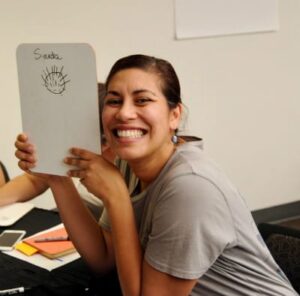

Off to a swell start
Back in 2013, I landed myself a really swell job. At San Diego Coastkeeper, Project SWELL is the name of our K-6th environmental curriculum. SWELL stands for “Stewardship: Water Education for Lifelong Leadership.” It’s a fitting title. Through Project SWELL, Coastkeeper teaches kids about water conservation, climate science, and the environmental issues specific to their communities.
I grew up in Puerto Rico and studied marine science, but it was in grad school as I was working for Sea Grant as a marine educator that I found my passion – teaching about environmental science, ocean life, and water conservation. Today, I work with an amazing nonprofit that protects not only the ocean itself, but the rivers, creeks, and rainfall that flow through our communities and meet the ocean at the coast — isn’t that swell?
Kids are the key
Of course, I’ve learned some important lessons along the way. After spending countless hours in classrooms and reading students’ answers to the pre-lesson and post-lesson surveys they had received, we realized kids are eager and enthusiastic to help save our Earth, and willing to do what it takes to make a real difference. Learning is the critical the first step to a more aware and engaged generation, but empowering a 10-year-old to take a real-life action that helps conserve water and energy is what makes my job as an educator so fulfilling.
Water and Climate Stewards
With this in mind, San Diego Coastkeeper recently launched a new project called Water and Climate Stewards of San Diego Bay. Through this program, we educate kids on the importance of making conscious decisions about the resources they consume. One example we use is the lifecycle of the humble straw to demonstrate how harmful single-use plastics can be when discarded. Kids are shocked to hear how much water and energy it takes to produce one straw, only for it to be used once and tossed, where it spends the rest of its days taking up space in a landfill. Improperly discarded, it may even become a fatal snack for a marine creature. It’s not just the longevity of plastic that startling, but the production as well. Did you know that it takes 22 gallons of water to make even one pound of plastic? It can take twice as much water to manufacture a plastic water bottle than the amount of water the bottle itself can hold. With some informed choices about what we buy and consume, water conservation can happen in surprising places.
Water waste and marine debris are a big problems for an elementary school student to tackle, but after one of our engaging and empowering lessons, students come away excited to implement the “Four R’s” into their daily lives, instead of fearful about what their future holds. The mantra is — REFUSE, REDUCE, REUSE, RECYCLE.
One step (or straw) at a time
As Nelson Mandela famously said, “Education is the most powerful weapon which you can use to change the world.” Or, in this case, save it. The ultimate goal of our education programs is to build the next generation of water and climate stewards, one kid, one teacher, one parent and one fewer plastic item at a time. Water conservation at home can start with one empowered, passionate kid saying no to one plastic straw. And it can grow from there!















